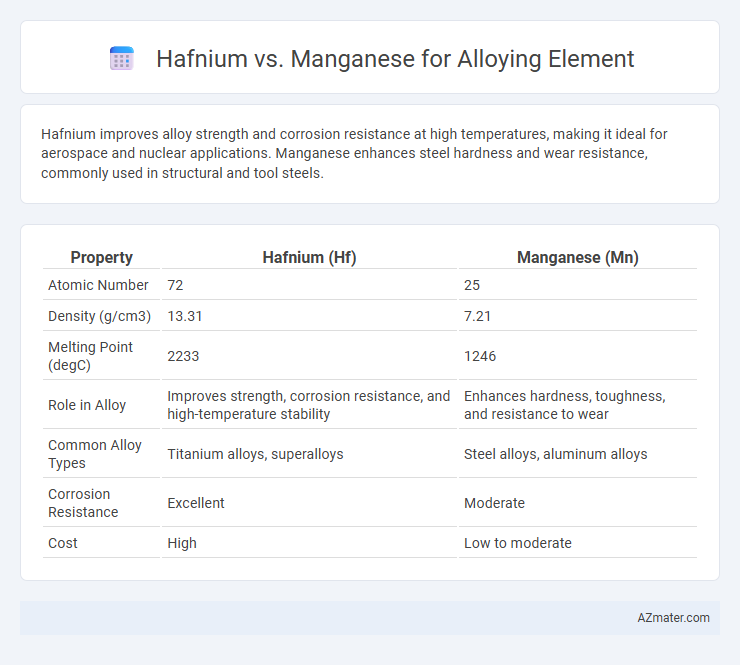Hafnium improves alloy strength and corrosion resistance at high temperatures, making it ideal for aerospace and nuclear applications. Manganese enhances steel hardness and wear resistance, commonly used in structural and tool steels.
Table of Comparison
| Property | Hafnium (Hf) | Manganese (Mn) |
|---|---|---|
| Atomic Number | 72 | 25 |
| Density (g/cm3) | 13.31 | 7.21 |
| Melting Point (degC) | 2233 | 1246 |
| Role in Alloy | Improves strength, corrosion resistance, and high-temperature stability | Enhances hardness, toughness, and resistance to wear |
| Common Alloy Types | Titanium alloys, superalloys | Steel alloys, aluminum alloys |
| Corrosion Resistance | Excellent | Moderate |
| Cost | High | Low to moderate |
Introduction to Alloying Elements: Hafnium and Manganese
Hafnium, known for its high melting point and excellent corrosion resistance, significantly improves the strength and creep resistance of superalloys used in aerospace and nuclear applications. Manganese enhances steel alloys by increasing hardness, toughness, and resistance to wear and impact, making it essential in construction and automotive industries. Both elements act as critical alloying agents, optimizing mechanical properties and performance under extreme conditions.
Chemical Properties of Hafnium and Manganese
Hafnium exhibits high corrosion resistance and a strong affinity for oxygen and nitrogen, enabling it to form stable oxides and nitrides that enhance alloy durability at elevated temperatures. Manganese, known for its variable oxidation states, acts as a deoxidizer and alloying agent that improves hardness and tensile strength by forming diverse manganese-based phases. The chemical inertness and refractory nature of hafnium contrast with manganese's versatility in oxidation, making each element uniquely valuable for specific alloying properties.
Physical Characteristics: Hafnium vs Manganese
Hafnium exhibits a high melting point of 2233degC and a density of 13.31 g/cm3, making it ideal for high-temperature alloy applications, whereas manganese has a lower melting point of 1244degC and a density of 7.43 g/cm3, contributing to its role in improving steel strength and hardness. Hafnium's ductility and corrosion resistance complement its use in aerospace and nuclear industries, while manganese's ability to increase toughness and wear resistance suits construction and manufacturing alloys. The distinct physical properties of hafnium and manganese dictate their specialized roles, with hafnium favored for extreme environments and manganese for structural reinforcement.
Role of Hafnium in Alloy Production
Hafnium significantly enhances the strength and corrosion resistance of superalloys used in aerospace and nuclear applications, making it crucial in high-performance alloy production. Its ability to improve creep resistance and stabilize the microstructure at elevated temperatures outperforms manganese, which primarily contributes to deoxidation and toughness in steel alloys. Hafnium's role in controlling grain boundary strength and oxidation stability is vital for manufacturing alloys subjected to extreme environments.
Role of Manganese in Alloy Fabrication
Manganese plays a critical role in alloy fabrication by enhancing the strength, toughness, and wear resistance of steel and aluminum alloys through its ability to improve hardenability and deoxidize molten metal. Unlike hafnium, which is primarily used for its high-temperature stability and corrosion resistance in superalloys, manganese contributes to grain refinement and imparts resistance to abrasion and impact in various alloy systems. The presence of manganese also aids in controlling sulfur content, reducing hot shortness, and promoting uniform mechanical properties in alloys.
Comparative Analysis: Hafnium vs Manganese in Steel Alloys
Hafnium enhances steel alloys by significantly improving high-temperature strength and oxidation resistance, making it ideal for aerospace and nuclear applications. Manganese primarily increases hardness and tensile strength while improving wear resistance and deoxidation in steel production, essential for structural and construction uses. Compared to manganese, hafnium offers superior performance in extreme environments but at a higher cost and lower availability, influencing selection based on specific alloying requirements and application conditions.
Corrosion Resistance: Hafnium vs Manganese
Hafnium exhibits superior corrosion resistance compared to manganese when used as an alloying element, especially in harsh environments such as high-temperature oxidation and acidic conditions. Manganese, while beneficial for enhancing strength and hardness, tends to form less protective oxide layers, leading to increased susceptibility to corrosion in aggressive media. The presence of hafnium significantly improves the durability and lifespan of alloys in corrosive applications by forming stable, adherent oxide films that inhibit degradation.
Impact on Mechanical Strength and Durability
Hafnium enhances mechanical strength and durability in alloys by improving grain boundary cohesion and oxidation resistance, making it especially valuable in high-temperature applications such as aerospace components. Manganese contributes to alloy toughness and wear resistance, primarily by refining microstructure and stabilizing austenite but generally offers lower high-temperature performance compared to hafnium. Alloys with hafnium exhibit superior creep resistance and long-term durability, whereas manganese-containing alloys provide cost-effective solutions for moderate mechanical strength and impact resistance.
Industrial Applications: Choosing Between Hafnium and Manganese
Hafnium enhances high-temperature strength and corrosion resistance in aerospace and nuclear reactor alloys, making it crucial for jet engine components and control rods. Manganese improves steel's tensile strength and wear resistance, widely used in construction, automotive, and manufacturing industries to produce durable structural steel and stainless steel. Selecting between hafnium and manganese depends on the required mechanical properties and operating environment, with hafnium preferred for extreme temperatures and Manganese for cost-effective strength enhancement.
Economic Considerations and Availability
Hafnium, though highly effective in enhancing alloy strength and corrosion resistance, is significantly costlier and less abundant than manganese, limiting its widespread industrial use. Manganese is widely available and economically favorable, making it the primary alloying element in steel production due to its cost-efficiency and ability to improve hardness and ductility. The disparity in market supply and price drives manufacturers to prefer manganese for large-scale applications, reserving hafnium for specialized, high-performance alloys where cost is less critical.

Infographic: Hafnium vs Manganese for Alloying Element
 azmater.com
azmater.com